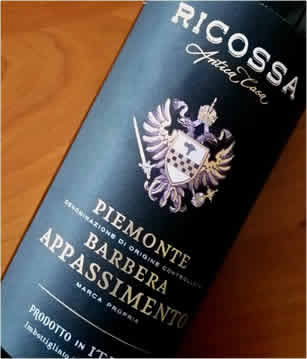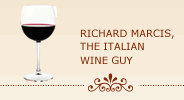Ricossa, Piemonte Barbera Appassimento 2014 (about $24)
I’m a big fan of Barbera wines. I like Barbera’s dark ruby color, high acidity, generous fruit flavors and moderate tannin all of which make for a versatile and food-friendly wine perfect for pairing with almost any food.
But this Barbera from the Ricossa Antica Casa winery is decidedly different. It utilizes the appassimento process, the same basic grape-drying process used for millennia throughout Italy and other Mediterranean-rim countries. Today, it is most commonly used in the Veneto region of Italy to make the famous Amarone and Recioto wines.
The basic process involves spreading recently harvested grapes on open trays or pallets that are then placed in special drying rooms. These drying rooms, called fruttaio, are well-ventilated and carefully monitored to ensure low temperatures and humidity levels. The drying process causes the grapes to shrivel and lose water which increases their sugar content and concentrates the grapes’ flavors. The grapes are left to dry for an extended period, typically from 3 to 4 months, before crushing and fermentation.
 But the Ricossa winery added a few new twists to the process. First, they used Barbera grapes instead of the Corvina, Corvinone, Rondinella and Oseleta grapes traditionally used to make Amarone. Second, the grapes are dried for 4 to 6 weeks rather than the lengthier 3 to 4 months used for Amarone. And lastly, the wine is aged in stainless steel instead of wood barrels and for a shorter period, 10 months total as opposed to the 2 year minimum required for Amarone.
But the Ricossa winery added a few new twists to the process. First, they used Barbera grapes instead of the Corvina, Corvinone, Rondinella and Oseleta grapes traditionally used to make Amarone. Second, the grapes are dried for 4 to 6 weeks rather than the lengthier 3 to 4 months used for Amarone. And lastly, the wine is aged in stainless steel instead of wood barrels and for a shorter period, 10 months total as opposed to the 2 year minimum required for Amarone.
The 2014 Ricossa Barbera is the first appassimento wine from the Piedmont region. It came to fruition through a year-long application process that was ultimately approved by the Piedmont authorities when they granted the Piemonte Barbera Appassimento DOC status in the fall of 2014.
The end result is a Barbera wine unlike traditional Italian Barbera wines and also different from the high-alcohol and sometimes sweet wines traditionally made with the appassimento process. In many respects it borrows some of the best features of both the variety and the process.
The wine has a beautiful ruby red color with a purple edge and pervasive and elegant aromas of red fruit, dried herbs and some floral notes. Its unique structure can be sensed immediately in the glass. A long sip reveals a soft wine, subtly structured with a smooth core of red fruit flavors and soft tannins. The wine still has good acidity but is less focused than that typically associated with Barbera. The use of dried grapes has resulted in a more-rounded, graceful and less acidic wine than traditional Barbera wines. It has a smooth and delicious delicacy of flavor that will keep you coming back for more.
The wine is ready to drink now but is not likely to be a long-term keeper and I recommend drinking it within the next 2 to 3 years.
The wine pairs nicely with a wide range of foods from roasted chicken and pasta dishes to hearty stews and grilled meats.
©Richard Marcis
November 7, 2016
To view other wine of the month selections, see Monthly Wine Reviews
Help keep this website ad-free and independent.
Consider making a contribution to support the work of WineWordsWisdom.com.


